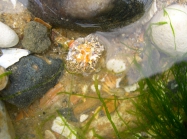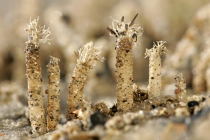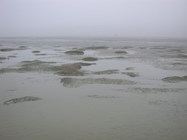WoRMS taxon details
Lanice conchilega (Pallas, 1766)
131495 (urn:lsid:marinespecies.org:taxname:131495)
page(s): 131-138, plate 9 [not plate 8, as stated in the text] figs. 14-22. [details]
Description A tube-living bristle worm whose body consists of two parts: a swollen anterior end with a reduced
head and specially...
head and specially formed segments and a narrowed posterior end. The head has numerous active
feeding tentacles. Three pairs of bright-red gills are present on the first three segments behind the
head. Measures up to 300 mm long. The tube consists of medium-sized to large sand grains with a
characteristic fan shape at the top. Several tubes together can form so-called ‘sand reefs’. [details]
Distribution Lanice conchilega is widely distributed on the Belgian part of the North Sea. However, the frequency of occurrence was the...
Distribution L. conchilega is widely distributed in the area, i.e. from the tidal estuaries to the Dogger Bank in the north. Locally it...
![]() The webpage text is licensed under a Creative Commons Attribution 4.0 License
The webpage text is licensed under a Creative Commons Attribution 4.0 License
page(s): 131-138, plate 9 [not plate 8, as stated in the text] figs. 14-22. [details]
original description (of Amphitrite flexuosa Delle Chiaje, 1828) delle Chiaje, Stefano. (1828). [POLYCHAETA context, Vol.3] Memorie sulla storia e notomia degli animali senza vertebre del Regno di Napoli. Volume 3. 1-232. Stamperia della Societa' Tipografica. Napoli. , available online at http://www.biodiversitylibrary.org/item/40491
page(s): 169 [as 'Anfitrite flessuosa'], 180 [as 'Amphitrite flexuosa'] [details]
original description (of Amphitrite tondi Delle Chiaje, 1828) delle Chiaje, Stefano. (1828). [POLYCHAETA context, Vol.3] Memorie sulla storia e notomia degli animali senza vertebre del Regno di Napoli. Volume 3. 1-232. Stamperia della Societa' Tipografica. Napoli. , available online at http://www.biodiversitylibrary.org/item/40491 [details]
original description (of Terebella artifex Sars, 1863) Sars, M. (1863). Geologiske og zoologiske Iagttagelser, anstillede paa en Reise i en Deel af Trondhjems Stift i Sommerren 1862. <em>Nyt Magazin for Naturvidenskaberne, Christiania.</em> 12(3): 253-340., available online at https://biodiversitylibrary.org/page/8058512
page(s): 310-318 [details]
original description (of Terebella pectoralis Quatrefages, 1866) Quatrefages, A. (1866). Histoire naturelle des Annelés marins et d'eau douce. Annélides et Géphyriens. <b>Volume 2.</b>. Première partie. 1-336. Deuxième Partie. 337-794. Explication des planches p.1-24. planches 1-20. Librarie Encyclopédique de Roret. Paris., available online at http://books.google.com/books?id=M_xNAAAAcAAJ
page(s): 358-359 [details]
original description (of Terebella prudens Quatrefages, 1866) Quatrefages, A. (1866). Histoire naturelle des Annelés marins et d'eau douce. Annélides et Géphyriens. <b>Volume 2.</b>. Première partie. 1-336. Deuxième Partie. 337-794. Explication des planches p.1-24. planches 1-20. Librarie Encyclopédique de Roret. Paris., available online at http://books.google.com/books?id=M_xNAAAAcAAJ
page(s): 357-358 [details]
original description (of Wartelia gonotheca Giard, 1878) Giard, Alfred. (1878). Sur les <i>Wartelia</i>, genre nouveau d'Annélides, considérés à tort comme des embryons de Térébelles. <em>Comptes Rendus Hebdomadaires des Séances de l'Académie des Sciences, Paris.</em> 86(18): 1147-1149., available online at https://www.biodiversitylibrary.org/page/4077268
page(s): 1148 [details]
original description (of Terebella littoralis Dalyell, 1853 [non Linnaean as 'littoralis seu arenaria']) Dalyell, J.G. (1853). The Powers of the Creator displayed in the Creation: or, observations on life amidst the various forms of the humbler tribes of animated nature with practical comments and illustrations. <em>van Voorst, London.</em> 2 pp.359. John van Voorst. London., available online at http://biodiversitylibrary.org/page/18804951
page(s): 183-191, plate XXVI figs. 1-7; note: three-part species name as "littoralis seu arenaria" [details]
context source (Deepsea) Intergovernmental Oceanographic Commission (IOC) of UNESCO. The Ocean Biogeographic Information System (OBIS), available online at http://www.iobis.org/ [details]
context source (HKRMS) BU. (2013). Provision of services for field sampling, species identification and data analysis of benthic faunal communities of Hong Kong marin waters. Final report submitted to EPD. [details]
context source (Schelde) Maris, T.; Beauchard, O.; Van Damme, S.; Van den Bergh, E.; Wijnhoven, S.; Meire, P. (2013). Referentiematrices en Ecotoopoppervlaktes Annex bij de Evaluatiemethodiek Schelde-estuarium Studie naar “Ecotoopoppervlaktes en intactness index”. <em>Monitor Taskforce Publication Series, 2013-01. NIOZ: Yerseke.</em> 35 pp. (look up in IMIS) [details]
context source (BeRMS 2020) Flanders Marine Institute (VLIZ); (2013). Data collected during the expeditions of the e-learning projects Expedition Zeeleeuw and Planet Ocean. [details]
additional source McIntosh, W.C. 1923. A monograph of the British marine annelids. Polychaeta, Sabellidae to Serpulidae. With additions to the British marine Polychaeta during the publication of the monograph. Ray Society of London, 4(2): 251-538. [details]
additional source Fauchald, K.; Granados-Barba, A.; Solís-Weiss, V. (2009). Polychaeta (Annelida) of the Gulf of Mexico, Pp. 751–788 in D.L. Felder and D.K. Camp (eds.). <em>Gulf of Mexico. Origin, Waters, and Biota. Volume 1, Biodiversity.</em> Texas A&M University Press, College Station, Texas., available online at https://books.google.es/books?id=CphA8hiwaFIC&lpg=PR1&pg=PA751 [details]
additional source Liu, J.Y. [Ruiyu] (ed.). (2008). Checklist of marine biota of China seas. <em>China Science Press.</em> 1267 pp. (look up in IMIS) [details] Available for editors
additional source Holtmann, S.E.; Groenewold, A.; Schrader, K.H.M.; Asjes, J.; Craeymeersch, J.A.; Duineveld, G.C.A.; van Bostelen, A.J.; van der Meer, J. (1996). Atlas of the zoobenthos of the Dutch continental shelf. Ministry of Transport, Public Works and Water Management: Rijswijk, The Netherlands. ISBN 90-369-4301-9. 243 pp. (look up in IMIS) [details]
additional source Bellan, G. (2001). Polychaeta, <i>in</i>: Costello, M.J. <i>et al.</i> (Ed.) (2001). European register of marine species: a check-list of the marine species in Europe and a bibliography of guides to their identification. <em>Collection Patrimoines Naturels.</em> 50: 214-231. (look up in IMIS)
note: checklist listing [details]
additional source Day, J. H. (1967). [Sedentaria] A monograph on the Polychaeta of Southern Africa. Part 2. Sedentaria. British Museum (Natural History), London. pp. 459–842., available online at http://www.biodiversitylibrary.org/bibliography/8596 [details]
additional source Muller, Y. (2004). Faune et flore du littoral du Nord, du Pas-de-Calais et de la Belgique: inventaire. [Coastal fauna and flora of the Nord, Pas-de-Calais and Belgium: inventory]. <em>Commission Régionale de Biologie Région Nord Pas-de-Calais: France.</em> 307 pp., available online at http://www.vliz.be/imisdocs/publications/145561.pdf [details]
additional source Fauvel, Pierre. (1909). Deuxième note préliminaire sur les polychètes provenant des campagnes de l'<i>Hirondelle</i> et de la <i>Princesse-Alice</i>, ou déposées dans la Musée Océanographique de Monaco. <em>Bulletin de l'Institute Océanographique de Monaco.</em> 142: 1-76., available online at http://biodiversitylibrary.org/page/46491917 [details]
additional source Hartman, Olga. (1959). Catalogue of the Polychaetous Annelids of the World. Parts 1 and 2. <em>Allan Hancock Foundation Occasional Paper.</em> 23: 1-628.
page(s): 506; note: checklist listing (original from Nereis conchilega) [details] Available for editors
additional source Hessle, Christian. (1917). Zur Kenntnis der terebellomorphen Polychaeten. <em>Zoologiska bidrag från Uppsala.</em> 5: 39-258, plates I-V., available online at https://biodiversitylibrary.org/page/38891407 [details]
redescription Hilbig, Brigitte 2000. Family Terebellidae Grube, 1851. pages 231-294. IN: Blake, James A.; Hilbig, Brigitte; and Scott, Paul Valentich. Taxonomic Atlas of the Benthic Fauna of the Santa Maria Basin and Western Santa Barbara Channel. 7 - The Annelida Part 4. Polychaeta: Fabelligeridae to Sternaspidae. Santa Barbara Museum of Natural History. Santa Barbara [details]
redescription Jirkov, I.A. (2001). [Polychaeta of the Arctic Ocean] (In Russian) Polikhety severnogo Ledovitogo Okeana. Yanus-K Press, Moscow, 632 pp., available online at https://www.researchgate.net/publication/259865957_Jirkov_2001_Polychaeta_of_the_North_Polar_Basin [details] Available for editors
redescription Lavesque, Nicolas; Daffe, Guillemine; Londoño-Mesa, Mario H.; Hutchings, Pat. (2021). Revision of the French Terebellidae sensu stricto (Annelida, Terebelliformia), with descriptions of nine new species. <em>Zootaxa.</em> 5038(1): 1-63., available online at https://www.mapress.com/zt/article/view/zootaxa.5038.1
page(s): 28, figures 12-13; note: Description based on non-type specimens from Chausey Islands, English Channel, and Nieuwpoort, Belgium specimens [details] Available for editors
new combination reference Malmgren, Anders Johan. (1866? vol for 1865). Nordiska Hafs-Annulater. [part three of three]. <em>Öfversigt af Königlich Vetenskapsakademiens förhandlingar, Stockholm.</em> 22(5): 355-410, plates XVIII-XXIX., available online at https://biodiversitylibrary.org/page/32339631
page(s): 380 [details]
 Present
Present  Present in aphia/obis/gbif/idigbio
Present in aphia/obis/gbif/idigbio  Inaccurate
Inaccurate  Introduced: alien
Introduced: alien  Containing type locality
Containing type locality
Additional information The L. conchilega reefs can be visualised using advanced remote sensing techniques, see Degraer et al (2008). [details]
Biology The sexes are separate and breeding occurs in spring and summer. The larvae have a long planktonic life, lasting about two months, and have been found in the period between April and August.
This polychacte lives in its straight tube that protrudes several centimetres from the sediment. The long tentacles are extended from the top for collecting particles. During collecting they are supported by fringe-like extensions of the tube. In case of danger L. conchilega quickly retracts in the tube. When damaged or covered by sediment, the animal rebuilds or extends its tube. This enables L. conchilega to survive in unstable deposits or areas with strong sedimentation. L. conchilega is a selective deposit feeder, ingesting foraminiferans, ciliates, copepods, algae and faeces of echinoderms and molluscs. Laboratory experiments revealed that filter feeding also plays a very important role in its nutrition.
High population densities of L. conchilega are attributed to the combination of periodically high concentrations of suspended matter and the ability to utilize different food sources.
L. conchilega is sensitive to low temperatures and therefore shows low densities in the area of the Wadden Sea after cold winters. [details]
Ecology The importance of L. conchilega for juvenile flatfishes was described in Vanaverbeke et al (2009). [details]
Ecology In intertidal areas, the tube patches are known to have consequences for the distribution and abundance of infaunal species by influencing the habitat structure, see Callaway ( 2006), Carey (1987), Feral (1989), Zuhlke (2001), Zuhlke et al. (1998). [details]
Ecology Recently, scientific evidence showed that L. conchilega qualifies as reef builder under the definition of the Habitats Directive. [details]
Ecology For more information on hydrodynamic influences of L. lanice, see Dittmann (1999), Eckman (1983), Heuers et al (1983). [details]
Ecology The influence on faunal abundance, species richness and species composition has been proved based on a long-term dataset, see Rabaut et al (2007), Van Hoey et al (2008). [details]
Importance The species can be used as a proxy in the management of marine resources and the conservation of marine biodiversity, see Rabaut et al (in press), Rabaut et al (2009) and Rabaut et al (2008). [details]
Morphology For more information on the physiology and tube structure see Jones and Jago (1993) and Ziegelmeier (1952). [details]
head and specially formed segments and a narrowed posterior end. The head has numerous active
feeding tentacles. Three pairs of bright-red gills are present on the first three segments behind the
head. Measures up to 300 mm long. The tube consists of medium-sized to large sand grains with a
characteristic fan shape at the top. Several tubes together can form so-called ‘sand reefs’. [details]
Distribution Lanice conchilega is widely distributed on the Belgian part of the North Sea. However, the frequency of occurrence was the highest in the near-coastal zone in both periods. Whereas the species occurred along the entire coast in the 1976-1986 period, Lanice conchilega appeared to be practically absent in the eastern coastal zone in the 1994-2001 period. In both periods densities up to 1,000s ind./m2 were observed with a maximum density of about 10,000 ind./m2 in the 1994-2001 period. [details]
Distribution L. conchilega is widely distributed in the area, i.e. from the tidal estuaries to the Dogger Bank in the north. Locally it is found with extremely large numbers (over 3000 ind./m²). The highest densities are found north of the Wadden islands, from Terschelling to the eastern boundary of the Dutch sector of the North Sea. When living in dense patches, the species can form an important part of the total biomass of an area. [details]
Habitat Lanice conchilega is found in various sediments but displays a preference for fine to medium-grained sediments (100 to 500 μm) with a relatively high mud content (10 to 40%). [details]
Habitat L. conchilega mainly lives in mixed sand bottoms and rarely in muddy bottoms. [details]
Morphology L. conchilega has an elongated body, consisting of two regions. The swollen front region has hair-like as well as hooked chaetae; the long, slender tail region only hooked ones. The species can reach a length of up to 150 mm with up to 300 segments. The head bears a dense tuft of long, thin tentacles. The first segment projects forwards, forming two lobes at both sides of the head. The next three segments carry branched gills. The worm is yellowish, pink or brown coloured with blood-red gills and white tentacles. L. conchilega builds a characteristic tube, consisting of cemented sand grains and shell fragments and with a typical fringe at the top end (Hartmann-Schröder, 1971; Holthe, 1986; Fish & Fish, 1989; Hayward & Ryland, 1990). [details]
| Language | Name | |
|---|---|---|
| Catalan | cuc paletacuc constructor de sorra | [details] |
| Dutch | zandkokerwormschelpkokerworm | [details] |
| English | sand mason wormsand mason | [details] |
| French | macaronilanice | [details] |
| German | SandröhrenwurmMuschelsammlerinBäumchenröhrenwurm | [details] |
| Spanish | gusano albañil | [details] |
Encyclopedia of Marine Life of Britain and Ireland
Marine Life Information Network - UK
PlanktonNet Image
To Barcode of Life (11 barcodes)
To Biodiversity Heritage Library (146 publications)
To European Nucleotide Archive (ENA)
To GenBank (1989 nucleotides; 7 proteins)
To Global Biotic Interactions (GloBI)
To NHMUK collection (Lanice conchilega (Pallas, 1766); NON-TYPE; NHMUK:ecatalogue:9474027)
To PESI
To USNM Invertebrate Zoology Annelida Collection (125 records)
To ITIS











